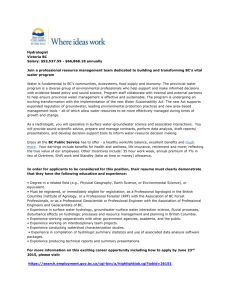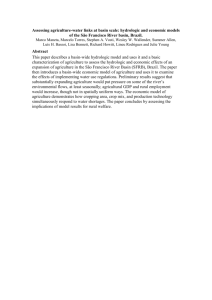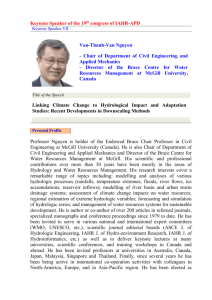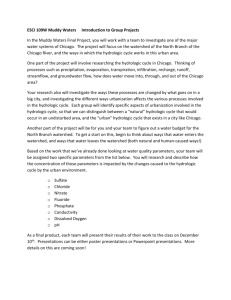Climate-Aquatics Workshop Blog Mailing #5: Massive Air & Stream Sensor... Ecologically Relevant Climate Downscaling
advertisement
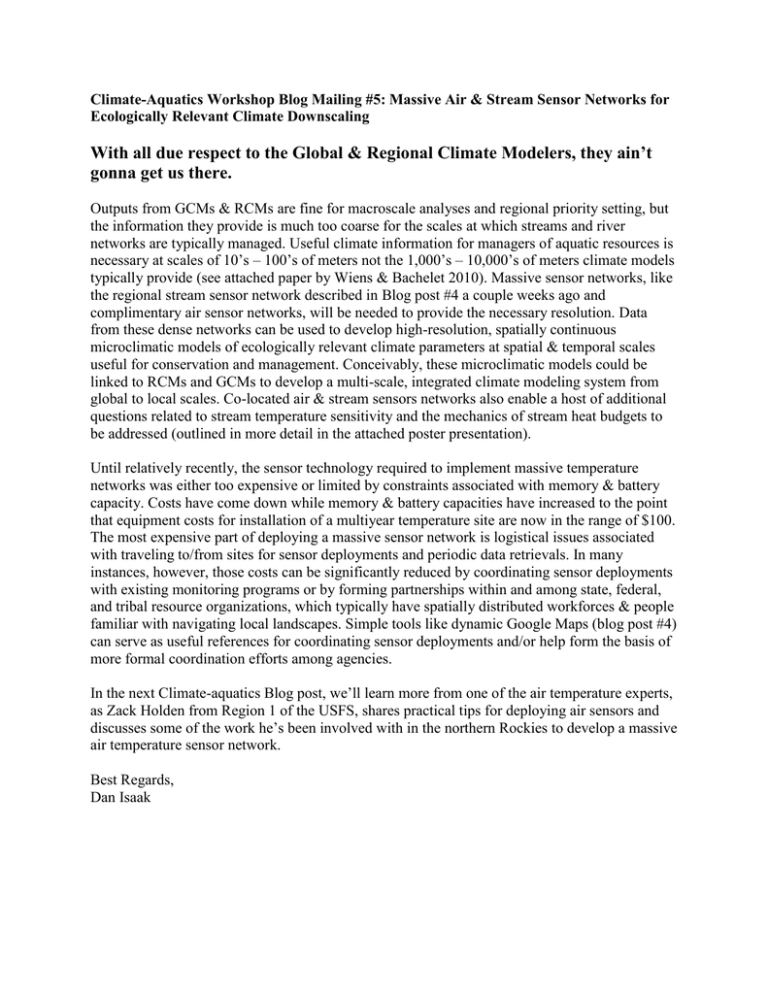
Climate-Aquatics Workshop Blog Mailing #5: Massive Air & Stream Sensor Networks for Ecologically Relevant Climate Downscaling With all due respect to the Global & Regional Climate Modelers, they ain’t gonna get us there. Outputs from GCMs & RCMs are fine for macroscale analyses and regional priority setting, but the information they provide is much too coarse for the scales at which streams and river networks are typically managed. Useful climate information for managers of aquatic resources is necessary at scales of 10’s – 100’s of meters not the 1,000’s – 10,000’s of meters climate models typically provide (see attached paper by Wiens & Bachelet 2010). Massive sensor networks, like the regional stream sensor network described in Blog post #4 a couple weeks ago and complimentary air sensor networks, will be needed to provide the necessary resolution. Data from these dense networks can be used to develop high-resolution, spatially continuous microclimatic models of ecologically relevant climate parameters at spatial & temporal scales useful for conservation and management. Conceivably, these microclimatic models could be linked to RCMs and GCMs to develop a multi-scale, integrated climate modeling system from global to local scales. Co-located air & stream sensors networks also enable a host of additional questions related to stream temperature sensitivity and the mechanics of stream heat budgets to be addressed (outlined in more detail in the attached poster presentation). Until relatively recently, the sensor technology required to implement massive temperature networks was either too expensive or limited by constraints associated with memory & battery capacity. Costs have come down while memory & battery capacities have increased to the point that equipment costs for installation of a multiyear temperature site are now in the range of $100. The most expensive part of deploying a massive sensor network is logistical issues associated with traveling to/from sites for sensor deployments and periodic data retrievals. In many instances, however, those costs can be significantly reduced by coordinating sensor deployments with existing monitoring programs or by forming partnerships within and among state, federal, and tribal resource organizations, which typically have spatially distributed workforces & people familiar with navigating local landscapes. Simple tools like dynamic Google Maps (blog post #4) can serve as useful references for coordinating sensor deployments and/or help form the basis of more formal coordination efforts among agencies. In the next Climate-aquatics Blog post, we’ll learn more from one of the air temperature experts, as Zack Holden from Region 1 of the USFS, shares practical tips for deploying air sensors and discusses some of the work he’s been involved with in the northern Rockies to develop a massive air temperature sensor network. Best Regards, Dan Isaak Subsequent Blog discussion… Dan, your post titled "They ain't going to get us there" has inspried me to reply. Although I suspect you didn't intend this, the title and first couple of sentences are misleading, and potentially disruptive to climate change vulnerability assessment and adaptation efforts -if they are interpreted as reinforcing the mistaken perception that GCM/RCM-driven hydrologic projections are not useful or relevant to resource management decision-making. Hydrologic projections driven by downscaled GCM and RCM results contain uncertainties -- like all models. This doesn't mean they are not useful or cannot help improve resource managers' understanding of the potential effects of climate change on the resources they are responsible for managing. Rather, it means we need to understand the primary sources of uncertainty in model results, including those associated with spatial scale, and use them accordingly. Fortunately, scientists have -- to an extent rarely achieved with other types of models used in resource management -- rigorously evaluated the sources and extent of these uncertainties, improved model structure and resolution where possible, and developed methods for clearly revealing and addressing some of the remaining uncertainties. Hydrologic projections driven by GCM/RCM output clearly provide scientifically credible and managerially important insights into the hydrologic consequences of projected changes in temperature and precipitation. There are hundreds of peer-reviewed scientific publications documenting the methods behind such projections and their resource management implications. Wenger et al.(2010), Elsner et al. (2010), and Mantua et al. (2010) are examples directly relevant to watershed vulnerability assessment and adaptation planning in the Northern Rockies. Ignoring these projections leaves decisionmakers with the default assumption that recent hydrologic patterns will remain unchanged in coming decades. There is very strong scientific evidence that this default assumption is incorrect. Without considering scienticially credible hydrologic projections, there is an increased likelihood that resource values will be unnecessarily diminished or lost, and that management investments will fail to achieve their objectives due to unanticipated (ignored) changes in hydrologic processes. Although GCM/RCM-driven hydrologic projections do not, and probably never will, provide unequivocal predictions of future conditions at the level of an invidividual stream reach, they do provide managers with credible information on the likely direction and magnitude of changes at regional and subregional scales. This information is very useful in (1) assessing the relative vulnerability of different subbasins and groups of watersheds to potential hydrologic changes and (2) identifying potential adaptation options. Investment in high-density air temperature monitoring will help improve our understanding of fine-scale spatial variability of air and stream temperatures. However, it will not eliminate all sources of uncertainty associated with hydrologic projections - or even the most significant sources of uncertainty (e.g., future precipitation trends and variability, including extremes). In addition, it likely will take at least a few years to implement the a massive air temperature monitoring system. In the meantime, we can - and should - use the best available scientific information regarding projected hydrologic changes. Evaluations of the vulenrability of ecosystems to climate change and other stressors requires consideration of both sensitivity and exposure. Higher spatial resolution of observed temperatures will help iimprove some aspects of sensitivity analysis. But meaninful consideration of expsure requires consideration of prjected changes in clamatic and hydrologic variability and extremes. Tools are available to help planners and managers understand and address the uncertainties inherent in GCM/RCM-driven hydrologic projections, such as estimates of model skill in simulating observed data for specific flow metrics, multi-model averages and estimates of inter-model spread, and "bracketed" hydroclimate scenarios. These information sources help bound the uncertainty. I hope your post does not discourage others from using these information resources and other credible scientific information regarding observed and projected hydrologic trends as part of increasing efforts to evaluate the vulnerability of hydrologic and aquatic resources, and identify potential adapation actions that might minimize undesirable climate change impacts. I appreciate the opportuntiy your blog provides to explore these issues. Scientists, resource managers, and the interested public need to engage in an open and robust dialogue to continually improve our understanding of "best practices" for addressing potential climate change impacts and identifying adaptation options. This dialogue could improve our understanding of: the strengths and limitations of a variety of relevant models and other data sources; the effectiveness of different vulnerability assessment scales; and effective risk communication/ management techniques to improve decision-making. Your blog provides an excellent forum for such a dialogue. Jim, Thanks for your thorough & thoughtful response. As I read it again, the title of blog post #5 two weeks ago was, in retrospect, poorly worded & overly provocative. A more appropriate title would have been, "RCMs/GCMs...they ain't gonna get us there--by themselves". The remainder of the distance to there ultimately being incumbant upon more detailed monitoring & modeling efforts that link to, & tier off of, the RCMs/GCMs, if the purpose is prioritization at fairly restricted spatial scales (i.e., individual forests, river basins). The blog post was not meant as a general indictment of RCMs/GCMs, as, like any model, they have particular things they're designed to do & certain space-time domains in which they do those things well. Though by no means perfect, GCMs/RCMs outputs & their derivatives are the best tools currently available, and are entirely appropriate, I believe, for setting priorities at regional & sub-regional scales. Moreover, they provide spatially continuous predictions useful for assessing relative risks & the amount of change across a geographic domain and can be run for a variety of different warming trajectories to accurately represent significant future uncertainties. Precise local historical climate information at weather stations and flow gages may often be available that confirms the historical trends predicted by the climate models but these monitoring records are relatively sparse & extrapolations from these records into the future will not represent the range of uncertainty, let alone the curvilinear nature of warming trajectories, given what appears to be an ongoing acceleration in warming rates. That said, there are also some important deficiencies to the climate models, of which the low spatial resolution in complex topographies is one of the more important. A strongly complimentary piece, therefore, could be the development of monitoring systems composed of dense sensor arrays to facilitate interpolated microclimatic surfaces that allow more precise local downscaling. As useful as these sensor arrays & microclimate models may ultimately prove to be, however, we don’t really have the luxury of waiting for them before starting the prioritization process given the threats posed by climate change. That’s in large part because, as you point out, there’s still years of work & data collection efforts before we’ll be close to having enough data & the know-how to build higher-resolution models across very large areas. Then there’s years of work to figure out how to make the microclimate models talk to the GCMs/RCMs, which they’ll have to do because the macro-scale models ultimately set the context for the micro-models and determine the warming scenarios that are run through the micro-scale models. They should all be complimentary & necessary pieces, but large challenges & significant work remains to create some sort of multiscalar, integrated system that could facilitate & optimize decision making across scales. Most of the remaining work it seems exists at the more local spatial scales, where dense sensor networks either have yet to be developed in many areas, or existing data have to be compiled & used effectively. As big as these challenges are, it’s exciting to see where things are & are headed in the northern Rockies. The partnership between USFS Region 1 with CIG to deliver GCM/RCM outputs and products specific to the region; some of the microclimate work by Zack Holden & his collaborators to develop dense air sensor networks, and ongoing efforts to compile the region’s stream temperature datasets, which are, quite literally, some of the largest and best in the world, hold tremendous potential. Linking all this climate information together, through a series of modeling platforms, could leverage huge information gains & also provides great opportunities for collaborative relationships & integrated management across forests, among agencies, and between research & management. We need the climate modelers & their models to map the most likely future scenarios, but they ultimately need us as well, in the USFS & other land management agencies across the West. Data that's collected in the field could and should be used for testing, validating, and continually improving the climate models so that they’re ever-evolving to meet the needs of resource management. " Dan


